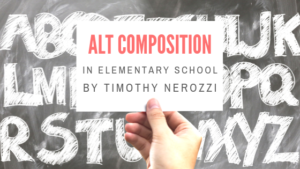Bio: Timothy Nerozzi is an American ALT living and working in Niigata City through the JET Program. He is a third-year teacher and works at both the elementary and junior high school levels.
“I like my town. We have a convenience store. We don’t have Tokyo Disneyland. I want a department store. Thank you.”
This is the kind of short essay I have been asking my students to regularly produce at the elementary level for the past two years.
These sentences are the textual equivalent to a child’s paint-by-numbers. Instead of allowing children to write the kinds of essays they want to write, we’re forcing them to simply choose words out of chapter-specific word banks and fill in the blanks.
I believe that the most effective way we can encourage children to write with both feeling and personal investment is to offer greater autonomy for them in choosing their own topics and essay prompts and using that freedom to build enthusiasm for self-expression.
And, in order to achieve this goal, I have implemented a weekly system of English composition practice with elementary classes at the fifth and sixth grade levels. This system is easy.
Though the curriculum is still ongoing and I have yet to see the full culmination of my composition-focused supplemental material, the results so far have been stunning, and fellow JETs may find a lot of use in reading about my experiences so far.
I am not a certified teacher. Outside of tutoring in my university days, I had very little experience in any form of education until being accepted into the JET program two years ago. Because of this, I am perhaps unequipped to dissect and explain my methodology in academic terms.
However, I hope that my experiences as related here can help readers consider new ways to engage with their students on effective composition.
The problem:
Our current elementary school education curriculum is undeniably speech-oriented. Writing, it feels, is a complete afterthought, shoved haphazardly in at the end of chapters or brought in from outside by ALTs or JTEs that want to supplement the course with more composition.
The alphabet, for example, is taught for exactly one chapter in fifth grade. Students memorize the general shape of the letters and their names. But they learn no phonics and that chapter contains no writing assignments or in-class writing practice – not even of just the individual letters.
As of this year, I’ve taken my students’ composition education into my own hands.
The methodology:
In both fifth grade and sixth grade, I begin the school year by setting aside ten minutes at the beginning of every class to practice writing the alphabet. This time is usually preceded by a standard call warm-up activity or discussion to get students into an “English mindset.
During the ten minutes of composition practice, the students practice four or five letters each class, from A to Z. Each letter is written five times in both upper-case and lower-case back to back in order to reinforce the two different forms of each letter.
All 26 English characters (upper and lower case) are memorized over the course of two months.
Most students do not finish those two months with a powerful recall ability for all 52 symbols.
However, they finish the alphabet course with a more effective grasp of the alphabet and the ability to think through the selection of a letter. You would be surprised at how effective this small gesture is in encouraging students to write.
Using a printed worksheet with the entire upper-case and lower-case alphabet printed in order, the students then begin each class with spelling practice. I read out English words to them, give their meaning, and then spell each one slowly. The students listen and try and write each letter as I say them.
After I spell the word three or four times, I go to the board and ask the students to spell out the word for me. Students check their own spelling against mine.
The twist, however, is that I am not typically teaching them vocabulary from the textbook.
The students select the majority of our words by putting their suggestions in a box outside the classroom, from which I select the best ones for class practice.
An “English Words I Want to Study” box is kept outside of a classroom in the school for one week and students are free to submit as many words as they like by writing them down on small paper ballots with their name and putting it into the box.
While any student can submit regardless of what classroom the box is kept outside of, the classroom changes each week in order to give each group of students a convenient chance to submit.
Students quickly fall into the schedule of the lessons – the submissions box never empty and often full.
The benefits:
While I wasn’t exactly sure how this lesson plan would turn out, I’ve noted a surprising variety of positive outcomes to this system.
Firstly, the students are ingraining the English alphabet into their brains through repetition and frequent writing practice. They are getting weekly exposure to the names of the characters and individually composing based on their own memory.
There are no cheat-sheets or hints. By attempting to write each letter I say as I say it, the students are training their recall ability and learning which letters they cannot generate quickly when writing. Repeated lessons strengthen this recall and make their writing faster and more fluid.
Secondly, the students are accumulating a greater understanding of how English words are constructed, and often pick up on spelling patterns not normally taught at their level. Silent “g” and “k” words most notably.
While our limited weekly time for composition means that there are very few opportunities to delve into and teach the quirks of English spelling thoroughly, I have observed some subtle improvements in students’ intuition for spelling abnormalities and patterns.
Thirdly, the students are selecting their own vocabulary, and in doing so, actively participating in furthering their own writing abilities. Allowing students to orientate, even to a small degree, their own education brings out a more spirited learning environment.
My suggestions box is often packed to the brim with slips of paper requesting a variety of words. We’ve covered “dinosaur,” “firefighter,” “knight,” and more.
Some Japanese words cannot be translated into a single word, so we’ve also done more complex terms such as “the four seasons,” “ceiling fan,” and “the United Kingdom,” among others.
Because these exercises were pre-empted by extensive alphabet practice, the length or spelling of the word(s) is irrelevant. Longer, more complex terms may require three or four spellings from me before everyone can finish, but it’s all possible, and the students know it.
Looking forward:
As we move into the last months of the school year, I look forward to pushing this composition practice as far as it can go. I will attempt to introduce small sentences instead of just words and may begin to experiment with allowing the students to guess spellings before I give them the information as a fun challenge.
This is my first year using this system, and so how it will move forward has always been fluid.
I don’t have a concrete plan for the classroom in the final months of this school year, but I’m eager to push my kids and encourage them to have fun studying the English words they choose to learn and using that knowledge to enhance their regular curriculum.
Don’t have any ideas? We have a list of topics to write about that need a writer. Email in your interest to write and we can set you up.
For upcoming blogs see the blogs tab here: http://www.alttrainingonline.com/blog.html



